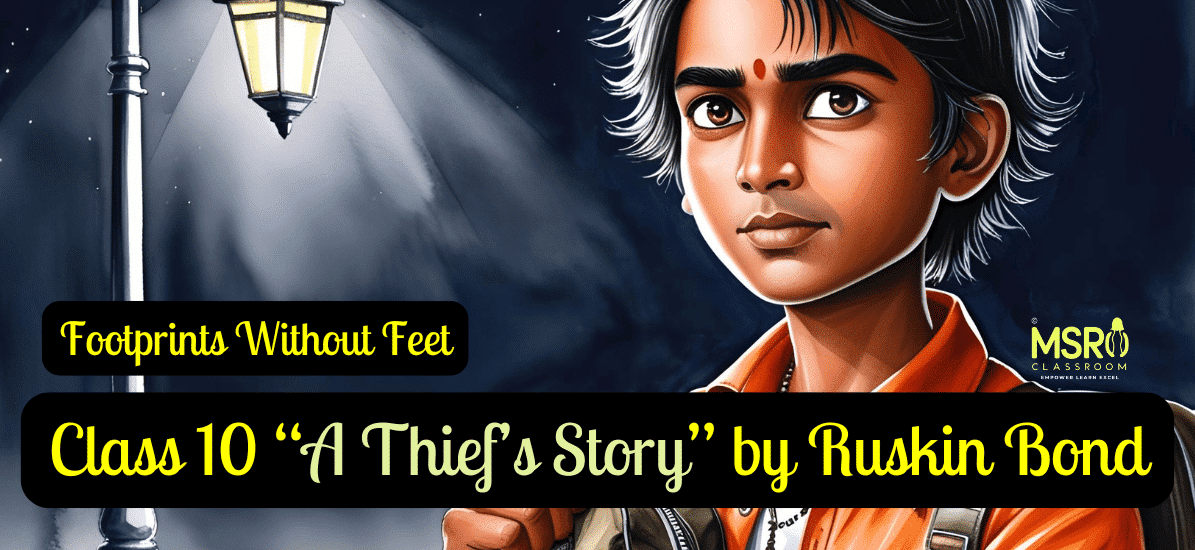Chapter 2 of Ruskin Bond’s ‘A Thief’s Story’ includes a summary, word meanings, themes, character sketches, important passages, and question answers, along with extra questions.
Chapter 2- A Thief’s Story by Ruskin Bond:
Table of Contents
Also Read: First Flight- Class 10 Prose
Idiomatic Expressions:
| Fairly successful hand – A skilled or proficient individual in a particular activity or occupation. Easy-going – Relaxed, laid-back, not easily stressed or upset. Get into the young man’s confidence – Gain the trust or reliance of the young man. A little flattery helps in making friends – Offering compliments can help form friendships or gain favour. A queer way to make a living – An unusual or unconventional method of earning money. easy to rob a greedy man – Greedy individuals are easier targets for theft because they accumulate wealth and may not notice missing funds as quickly. Lost the chance to get away – Missed the opportunity to escape or leave. Showed only a touch of sadness – Displayed just a tiny amount of sorrow or regret. In the excitement of the theft – During the rush or thrill of committing the theft. Clouded moonlight – Moonlight obscured or partially blocked by clouds. My heart sank – Felt a sudden drop or decrease in hope or optimism. Spirits rose – Felt uplifted or encouraged. The smile came by itself, without any effort – It appeared naturally, without being forced or contrived. Kind and simple enough for my purpose – Possessing a demeanour/behaviour that seemed benevolent and naive, suitable for what the thief intended to do. I hadn’t had much luck of late – Recently, the thief has not experienced much success or good fortune. Anil made money by fits and starts – Anil’s income fluctuated irregularly; he earned money inconsistently or unpredictably. Friends were more trouble than help – Believing friendships caused more problems than they solved. |
Summary “A Thief’s Story”:
In “The Thief’s Story” by Ruskin Bond, a seasoned thief posing as Hari Singh befriends Anil, a trusting young man. The 15-year-old thief lies to Anil for a job (cook) and a place to stay. Despite planning to rob Anil, he finds himself unable to do it when he sees Anil’s trusting nature. After attempting to run away with stolen money, he feels guilty and returns it.
Anil, aware of the theft, pretends not to notice, and they continue living together. Eventually, Anil starts paying him and teaches him to read and write. The young thief learns the value of trust and changes his ways influenced by Anil’s goodwill and faith in him.
Theme “A Thief’s Story”:
Redemption and Power of Trust:
“The Thief’s Story” explores the theme of redemption and the power of trust. The story highlights the transformative effect of genuine human connection through the thief’s interactions with Anil, a kind-hearted man who offers him friendship and employment despite his criminal past. Despite the temptation to steal from Anil, the thief ultimately returns the stolen money, recognising the value of trust and integrity over material gain.
The story highlights the importance of forgiveness, second chances, and the potential for personal growth when treated with kindness and understanding.
Explanation for Auditory Learners:
Duration: 9 minutes
English Subtitles and Time Stamps are available.
Character Sketch:
Character Sketch of The Thief:
The thief in “The Thief’s Story” is a complex character shaped by a life of deceit and survival. A detailed character sketch follows.
Name: Hari Singh (a pseudonym; he changes his name regularly to avoid detection).
Age: Approximately 15 years old.
Occupation: A thief by profession, experienced and reasonably successful.
Appearance: Thin and likely malnourished, with scars on his face.
Personality:
- Manipulative: Lies about his identity and skills to gain trust.
- Opportunistic: Seeks out opportunities to exploit others for personal gain.
- Resourceful: Adapts quickly to new situations, such as changing names regularly to evade capture.
- Initially selfish: Considers stealing from Anil, his employer, to satisfy his desires.
- Reflective: Contemplates the consequences of his actions and the potential for personal growth.
Skills:
- Skilled in thievery: Experienced and successful in his criminal endeavours.
- Limited education: Need help reading or writing initially but eager to learn.
Motivations:
- Survival: Steals to meet his basic needs and maintain his lifestyle.
- Self-improvement: Recognizes the value of education and seeks to better himself.
- Transformation: Influenced by Anil’s kindness and trust, he begins to reconsider his actions and ultimately chooses to return the stolen money, indicating a potential for redemption and change.
Character Sketch of Anil:
In “A Thief’s Story,” a kind-hearted writer, Anil, extends trust and guidance to a young thief, influencing his journey towards redemption and self-improvement. Following is Anil’s detailed character sketch.
Name: Anil.
Age: Approximately 25 years old.
Occupation: Writer for magazines; earns money by selling books to publishers.
Appearance: Tall, lean, and easy-going in demeanour.
Personality:
- Kind-hearted: Demonstrates kindness and compassion towards others, including the thief.
- Trusting: Shows a high level of trust, even towards someone with a criminal background.
- Generous: Offers employment and lodging to the thief without expecting immediate payment.
- Patient: Teaches the thief basic skills such as cooking and writing despite initial setbacks.
- Celebratory: Enjoys life’s small victories, such as receiving payment for his writing.
Skills:
- Writing: Skilled in writing for magazines and selling books to publishers.
- Teaching: Patiently imparts knowledge and skills to the thief, such as cooking and writing.
- Wrestling: Possesses skill and knowledge in wrestling, as indicated by his interest in watching wrestling matches.
Motivations:
- Friendship: Values human connection and seeks companionship, even with someone from a different background.
- Creativity: Finds fulfilment in his writing and celebrates his successes.
- Empathy: Understands the struggles of others and offers assistance without judgment.
Impact on the Thief: Catalyses the thief’s moral transformation, inspiring him to reconsider his actions and strive for personal growth. Anil’s kindness and trust play a pivotal role in the thief’s decision to return the stolen money and pursue a better path in life.
Question Answers “A Thief’s Story”:
Comprehension Questions:
Q1: Who does ‘I’ refer to in this story?
A1: ‘I’ refers to the narrator, who is a thief.
Q2: What is he “a fairly successful hand” at?
A2: The narrator is “a fairly successful hand” at thievery, indicating they are skilled and experienced in criminal activities.
Q3: What does he get from Anil in return for his work?
A3: In return for his work, the narrator receives food and lodging from Anil. Anil promises to teach the narrator basic skills like cooking, writing, and arithmetic.
Q4: How does the thief think Anil will react to the theft?
A4: The thief anticipates that Anil’s reaction to the theft will be sadness, not primarily because of the loss of money but because of the breach of trust.
Q5: What does he say about the different reactions of people when they are robbed?
A5: The thief observes different reactions from people when they are robbed based on their social status. Greedy individuals tend to show fear, rich ones display anger, and poor individuals exhibit acceptance.
Q6: Does Anil realise that he has been robbed?
A6: Anil realises that he has been robbed, as indicated by his actions and interactions with the narrator later in the story.
Think About It:
Q1: What are Hari Singh’s reactions to the prospect of receiving an education? Do they change over time? What makes him return to Anil?
A1: At first, Hari Singh’s reactions to the prospect of receiving an education are pragmatic and opportunistic. He sees learning to read and write as a means to achieve greater success and opportunities in life, as he thought, “I knew that once I could write like an educated man, there would be no limit to what I could achieve.”
However, as the story progresses, Hari Singh’s perspective evolves. He begins to recognise the importance of education not just for material gain but also for personal growth and becoming a respected member of society. This is evident in his later thoughts, where he reflects on the significance of being a “clever and respected man.”
He returns to Anil because he realises that success and fulfilment come from more than material wealth or criminal activities. Learning to read and write, along with the genuine connection he has formed with Anil, motivates him to seek redemption and pursue a better path in life.
Q2: Why does not Anil hand the thief over to the police? Do you think most people would have done so? In what ways is Anil different from such employers?
A2: Anil doesn’t hand the thief over to the police because he values trust and forgiveness over punishment. He demonstrates empathy and understanding towards the thief, recognising that his actions stem from a lack of education and opportunity rather than inherent malice. Anil’s decision not to involve the police reflects his compassionate and forgiving nature, which is evident throughout the story.
Most people might have been tempted to report the theft to the authorities, but Anil is different. He chooses to address the issue personally and offers the thief a chance for redemption by continuing to provide guidance and support. Anil’s actions highlight his empathy and belief in the potential for growth and change in others, setting him apart from more punitive or judgmental individuals.
Talk About It:
Q1: Do you think people like Anil and Hari Singh are found only in fiction, or are there such people in real life?
A1: People like Anil and Hari Singh exist in real life, although they may be less common than in fiction. Some individuals exhibit qualities of kindness, empathy, and forgiveness, like Anil, and those who undergo personal growth and seek redemption, like Hari Singh. While not everyone may possess these traits to the same extent, certain individuals demonstrate similar characteristics in their interactions.
Q2: Do you think it is a significant detail in the story that Anil is a struggling writer? Does this explain his behaviour in any way?
A2: Anil’s struggle as a writer is a significant detail in the story as it sheds light on his behaviour and character. His profession suggests that he is likely empathetic, imaginative, and open-minded, which aligns with his compassionate treatment of the thief. His struggles with financial instability may contribute to his understanding and tolerance of the thief’s circumstances.
Furthermore, Anil’s occupation as a writer highlights the theme of education and self-improvement in the story. He strives to educate the thief and encourages him to pursue learning and personal growth. Anil’s profession enriches the narrative by providing insight into his motivations and actions.
Q3: Have you met anyone like Hari Singh? Can you think and imagine the circumstances that can turn a fifteen-year-old boy into a thief?
A3: (Subjective Answer)
I haven’t met anyone like Hari Singh, but I’ve encountered people who have faced similar challenges and circumstances that can lead to criminal behaviour.
Various factors can contribute to a teenager becoming a thief, including poverty, lack of education, family issues, peer pressure, and societal influences. For example, growing up in a disadvantaged environment with limited access to resources and opportunities may push a young person towards criminal activities as a means of survival or a coping mechanism. Also, exposure to negative influences or role models, such as involvement with criminal gangs or substance abuse, can play a significant role in shaping a teenager’s behaviour.
Q4: Where is the story set? Do you think the characters in the story talked to each other in English?
A4: The story is set in a place with names like “Jumna Sweet Shop” and “Lucknow Express,” which suggest an Indian setting, probably Uttar Pradesh or the city of Lucknow.
The characters in the story probably conversed in Hindi. However, Anil might be literate in English, given his occupation as a writer.
Extra Questions “A Thief’s Story”:
Short Answer Type Questions:
Q1: What initially attracted the narrator to Anil, and why did he decide to work for him?
A1: The narrator was drawn to Anil’s easy-going and kind demeanour, believing he could exploit his trust. He chose to work for Anil to gain confidence and benefit from his generosity, aiming to exploit his simplicity for personal gain.
Q2: How did Anil help the narrator improve his practical and educational skills?
A2: Anil taught the narrator cooking skills and promised further education, demonstrating patience and kindness. He provided opportunities for practical learning through daily tasks and initiated educational sessions to improve the narrator’s literacy and numeracy. Anil’s support and guidance were instrumental in enhancing the narrator’s life’s practical and academic aspects.
Q3: What dilemma did the narrator face when considering stealing from Anil, and what ultimately led him to return the money?
A3: The narrator struggles with a moral dilemma when contemplating stealing from Anil. Despite the temptation of easy money, he recognised the betrayal of Anil’s trust and the potential loss of their relationship. Ultimately, his conscience prevailed, leading him to return the money and preserve the bond of trust with Anil.
Q4: How did Anil react to the narrator’s return of the stolen money?
A4: Anil reacted calmly and generously to Hari Singh’s return of the stolen money. He offered him a regular payment and continued their educational sessions without showing any sign that he was aware of the theft. Anil’s understanding and kindness reaffirmed his trust, fostering a sense of gratitude and relief in Hari Singh.
Q5: What strategy did the narrator initially employ to gain Anil’s trust, and did it prove effective?
A5: The narrator employs flattery and lies, pretending admiration for Anil’s demeanour and skills. Despite initial suspicion, the narrator’s persistent appeal and charming demeanour eventually win Anil over, demonstrating the effectiveness of manipulation in gaining trust. Anil’s eventual trust facilitated/enabled the narrator’s opportunity for personal gain.
Q6: Describe the narrator’s internal conflict as he contemplated stealing from Anil.
A6: The narrator experiences a profound internal conflict as he contemplates stealing from Anil. While tempted by the prospect of easy money, he grapples/struggles with guilt and betrayal, recognising the significance of Anil’s trust and the potential consequences of his actions on their relationship.
Q7: How did the narrator’s perception of Anil change throughout the story, and what did he ultimately learn from their relationship?
A7: The narrator’s perception of Anil evolved from seeing him as an easy target to appreciating his kindness and generosity. Through their relationship, the narrator learns the value of trust, honesty, and genuine human connection. He realised the importance of integrity and the impact of one’s actions on others.
Q8: Reflecting on the story, what themes or moral lessons can be drawn from the narrator’s experience with Anil?
A8: The story highlights themes of trust, morality, and redemption. It highlights the importance of integrity and the consequences of betraying trust. Through the narrator’s experience with Anil, readers learn the value of honesty, empathy, and the potential for redemption through genuine remorse and ethical behaviour.
Q9: What role does trust play in the relationship between the narrator and Anil, and how is it tested throughout the story?
A9: Trust is fundamental in the narrator and Anil’s relationship, serving as the foundation of their bond. It’s tested when the narrator contemplates stealing from Anil, risking betrayal. However, the narrator’s decision to return the stolen money reaffirms trust, highlighting its significance in fostering genuine connections and mutual respect.
Q10: In what ways does Anil’s generosity and kindness influence the narrator’s actions and decisions?
A10: Anil’s generosity and kindness instil a sense of gratitude and loyalty in the narrator. His benevolent actions inspire the narrator to reciprocate with honesty and integrity, shaping his decisions. Anil’s compassion fosters a desire in the narrator to preserve their relationship and uphold the trust placed in him.
Long Answer Type Questions:
Q1: What motivated the thief to steal from Anil despite the trust he had earned?
A1: The thief’s decision to steal from Anil stemmed from a combination of factors. Despite earning Anil’s trust and enjoying a stable position, the thief felt dissatisfied with his circumstances and longed to taste the wealth he believed he deserved. Anil’s trusting nature and lack of suspicion made him an easy target for the thief’s criminal impulses.
The thief’s perception of Anil’s financial situation, particularly his sporadic income and apparent frivolous spending, likely justified the theft in the thief’s mind. The allure/appeal of instant gratification and the desire for a better life fueled the thief’s decision to betray Anil’s trust and seize the opportunity presented by the vulnerable moment.
Q2: What is revealed about the thief’s feelings towards Anil’s trust after the theft?
A2: After the theft, the thief’s feelings towards Anil’s trust transform. Initially driven by opportunism and a desire for personal gain, the thief experiences a sense of guilt and remorse upon realising the depth of Anil’s trust in him. The theft challenges the thief’s perception of trust and highlights the significance of the relationship with Anil beyond mere material gain. Despite initially betraying Anil’s trust, the thief begins to appreciate the value of their genuine connection.
This newfound understanding prompts the thief to return the stolen money, indicating a growing sense of responsibility and a desire to redeem themselves in Anil’s eyes. The experience prompts the thief to reevaluate their priorities and ultimately fosters a deeper appreciation for the trust and kindness Anil has shown them.
Q3: How does the thief feel when Anil offers him a job and teaches him to read and write?
A3: When Anil offers the thief a job and begins to teach him to read and write, the thief experiences a mixture of gratitude, surprise, and a sense of opportunity. Initially accustomed to a life of petty crime and survival, the thief is taken aback by Anil’s generosity and genuine interest in helping him improve his circumstances.
The offer of employment and the opportunity to learn new skills signify a chance for the thief to break free from their past and build a better future. Grateful for the trust and support extended by Anil, the thief feels a sense of hope and possibility, recognising the potential for personal growth and advancement that comes with Anil’s mentorship.
Q4: Why does the thief ultimately decide to return the stolen money?
A4: The thief, Hari Singh, ultimately returns the stolen money due to guilt, remorse, and a growing appreciation for Anil’s trust and kindness. Despite initially giving in to the temptation of theft, his conscience weighs heavily on him as he reflects on the depth of Anil’s trust and their genuine connection. Returning the money becomes a way for him to seek redemption and repair the breach of trust he has caused.
Moreover, Hari Singh realises that his actions betray Anil and jeopardise the opportunity for personal growth and transformation that Anil has offered through employment and education. By returning the stolen money, he attempts to realign with his moral compass and honour the trust Anil has placed in him.
Q5: How does Anil react when he realises the thief stole from him?
A5: When Anil realises the thief stole from him, he reacts surprisingly calmly and understandingly. Despite the betrayal of trust, Anil maintains his composure and shows no overt anger or hostility towards the thief. Instead, he subtly acknowledges the theft by offering the thief a wet fifty-rupee note, indicating his awareness of the situation without directly accusing or confronting the thief.
Anil’s response reflects his empathetic nature and deep understanding of human frailties, suggesting a willingness to forgive and move forward without harbouring resentment. His measured reaction demonstrates a profound sense of compassion and highlights the strength of his character in the face of adversity.
Q6: What does the thief learn about himself and his aspirations through this experience?
A6: Through this experience, the thief, Hari Singh, undergoes significant introspection and growth, gaining insight into his character and aspirations. Initially driven by selfish desires and opportunism, he confronts the consequences of his actions and wrestles with guilt and remorse. The experience prompts him to reassess his values and priorities, realising the importance of integrity, trust, and genuine human connections over material gain.
Moreover, Hari Singh discovers a desire for personal growth and redemption, recognising the transformative power of education and the opportunity for a better future that Anil’s mentorship offers. Ultimately, he learns the value of honesty, empathy, and self-improvement, paving the way for a newfound sense of purpose and direction.
Q7: How does the thief perceive the thieves throughout the story?
A7: Throughout the story, the thief’s perception of trust evolves significantly. Initially, the thief views trust primarily as an opportunity for exploitation, seeing Anil’s trusting nature as a vulnerability to be exploited for personal gain. However, as the story progresses, the thief begins to recognise the intrinsic value of trust beyond mere material benefit.
The theft challenges the thief’s understanding of trust, leading to guilt and remorse as he comes to appreciate the depth of Anil’s trust and their genuine connection. Ultimately, the thief learns to honour and value trust as a cornerstone of meaningful relationships, realising that it is not only a source of vulnerability but also a foundation for mutual respect, integrity, and personal growth.
Q8: How does the setting shape the thief’s decisions?
A8: The setting plays a crucial role in shaping the thief’s decisions throughout the story. Set in a modest urban environment, the thief’s surroundings reflect a life of poverty and struggle, where opportunities for advancement are scarce. The dreary atmosphere and lack of prospects contribute to the thief’s initial reliance on criminal activities for survival.
However, introducing Anil’s home above the Jumna Sweet Shop provides a contrasting environment characterised by warmth, trust, and potential for growth. This setting catalyses the thief’s moral and personal development, prompting him to reassess his priorities and aspirations. Ultimately, the juxtaposition of environments highlights the transformative power of trust, kindness, and opportunity in shaping the thief’s journey towards redemption and self-discovery.
Q9: How does the story’s resolution reflect the themes of trust and redemption?
A9: The story’s resolution reflects the themes of trust and redemption through the thief’s decision to return the stolen money to Anil. Despite succumbing to temptation initially, the thief’s repentance demonstrates a newfound commitment to integrity and honour. By returning the money, the thief seeks to restore the broken trust, acknowledging the significance of Anil’s faith in them.
This restitution (return of stolen goods) symbolises the thief’s journey towards redemption as he confronts his past transgressions and strives to make amends. Furthermore, Anil’s compassionate response to the theft highlights the transformative power of trust and forgiveness, reinforcing the theme of redemption as the thief seeks to rebuild their relationship with Anil on a foundation of honesty and mutual respect.
Important Passages/Lines “A Thief’s Story”:
1. “I was still a thief when I met Anil. And though only 15, I was an experienced and fairly successful hand.” The opening scene sets the tone for the thief’s character and establishes the story’s central conflict. It introduces the thief as a thief, despite being only 15 years old, indicating a life of crime from a young age. The phrase “experienced and fairly successful hand” suggests that the thief is adept at thievery, foreshadowing their internal struggle when meeting Anil.
2. “I hadn’t had much luck of late and thought I might be able to get into the young man’s confidence.” The thief reveals his motivation for approaching Anil. Despite his experience as a thief, he admits to a recent lack of luck. Desperate for a successful opportunity, he believes Anil may be someone he can manipulate or befriend to further his interests.
3. “Anil was watching a wrestling match when I approached him. He was about 25 — a tall, lean fellow — and he looked easy-going, kind and simple enough for my purpose.” The thief describes Anil’s appearance and demeanour upon his first encounter with him. Anil is portrayed as approachable and unassuming, which makes him an appealing target for Hari Singh’s schemes. The description of Anil as “easy-going, kind and simple” suggests that he may be easily manipulated, further enticing the thief to try and gain his trust.
4. “He took me to his room over the Jumna Sweet Shop and told me I could sleep on the balcony.” The scene depicts Anil’s initial hospitality towards the thief. Despite their limited interaction, Anil offers the thief a place to stay in his room, demonstrating kindness and trust. This act of generosity sets the stage for developing their relationship and the thief’s internal conflict as he grapples with the idea of betraying Anil’s trust.
5. “Well, it’s time I did some real work, I told myself; I’m out of practice.” The line reflects the thief’s realisation that he needs to return to his thieving ways after a period of inactivity. Despite his experience, he acknowledges feeling out of practice, indicating a sense of self-awareness about his skills and abilities in his illicit profession.
6. “And that is why it was so difficult to rob him.” The thief reflects on the difficulty of robbing Anil due to his trusting nature. Unlike greedy individuals, who may be easier targets, Anil’s innocence and trustworthiness make it challenging for the thief to betray him. It highlights the thief’s moral dilemma as he grapples with stealing from someone who has shown him kindness.
7. “When the train had gone, I found myself standing alone on the deserted platform.” After missing the opportunity to escape on the departing train, the moment marks a turning point in the story, where the thief must confront the consequences of his actions and decide his next course of action. The deserted platform symbolises his isolation and uncertainty as he contemplates his choices.
8. “Anil’s face would show only a touch of sadness when he discovered the theft. Not for the loss of money, but for the loss of trust.” The thief predicts Anil’s reaction to discovering the theft, anticipating that he will feel a sense of sadness primarily due to the breach of trust rather than the loss of money. This insight into Anil’s character reveals his forgiving nature and emphasises the significance of trust in their relationship. The line highlights the moral lesson learned by the thief about the importance of integrity and the value of genuine human connections over material wealth.
9. “Anil’s money. In the morning he would probably have given me two or three rupees to go to the cinema, but now I had it all.” Reflects the thief’s realisation of the consequences of his actions. He acknowledges that if he hadn’t stolen from Anil, Anil would have likely shared a small amount of money with him for leisure activities like going to the cinema. However, by stealing from him, he now possesses all of Anil’s money, indicating a sense of guilt or remorse over his betrayal of Anil’s trust.
10. “I should go back to Anil, I told myself, if only to learn to read and write.” Here, the thief acknowledges a sense of responsibility and a desire for self-improvement despite his criminal behaviour. Despite having stolen from Anil, he recognises the value of returning to him, if only to continue his education and improve himself. This line hints at the thief’s internal conflict and his recognition of the importance of learning and personal growth.
11. “I opened the door quietly, then stood in the doorway, in clouded moonlight. Anil was still asleep.” The imagery of standing in the doorway in clouded moonlight creates a tense atmosphere, emphasising the weight of the thief’s actions and the uncertainty of the situation.
12. “He knew. But neither his lips nor his eyes showed anything.” Despite the thief’s attempt to return the stolen money without being detected, he realises that Anil is aware of what he has done. However, Anil’s outward expression remains neutral, neither confirming nor condemning the thief’s actions. This suggests Anil’s forgiveness or understanding, adding complexity to their relationship and the thief’s internal conflict.
13. “And the smile came by itself, without any effort.” The thief’s involuntary smile at the end of the story symbolises a sense of relief or redemption. Despite his wrongdoing, he finds solace in Anil’s forgiveness or acceptance. The smile coming “by itself, without any effort” suggests a genuine emotional connection and reconciliation between the thief and Anil, highlighting the power of forgiveness and redemption in human relationships.
14. “In my short career ….The greedy man showed fear; the rich man showed anger; the poor man showed acceptance……….Not for the loss of money, but for the loss of trust.”
The thief reflects on his experience as a thief and his realisation of people’s reactions when they lose something valuable. He mentions that when people lose their belongings, their reactions depend on their social status: greedy individuals show fear, rich ones show anger, and poor ones show acceptance. However, the thief predicts that when Anil discovers the theft, he will only feel a touch of sadness—not because of the lost money, but because of the breach of trust.
15. “I had forgotten about them in the excitement of the theft. Whole sentences……………… But to be a really big man, a clever and respected man, was something else. I should go back to Anil, I told myself, if only to learn to read and write. “
The thief admits he had forgotten his desire to learn to read and write in the excitement of stealing. He acknowledges that while stealing can bring immediate gains, getting caught is easy. Instead, he realises that true success and respect come from education and knowledge. He decides to return to Anil to make amends, pursue his education, and become a better person.





